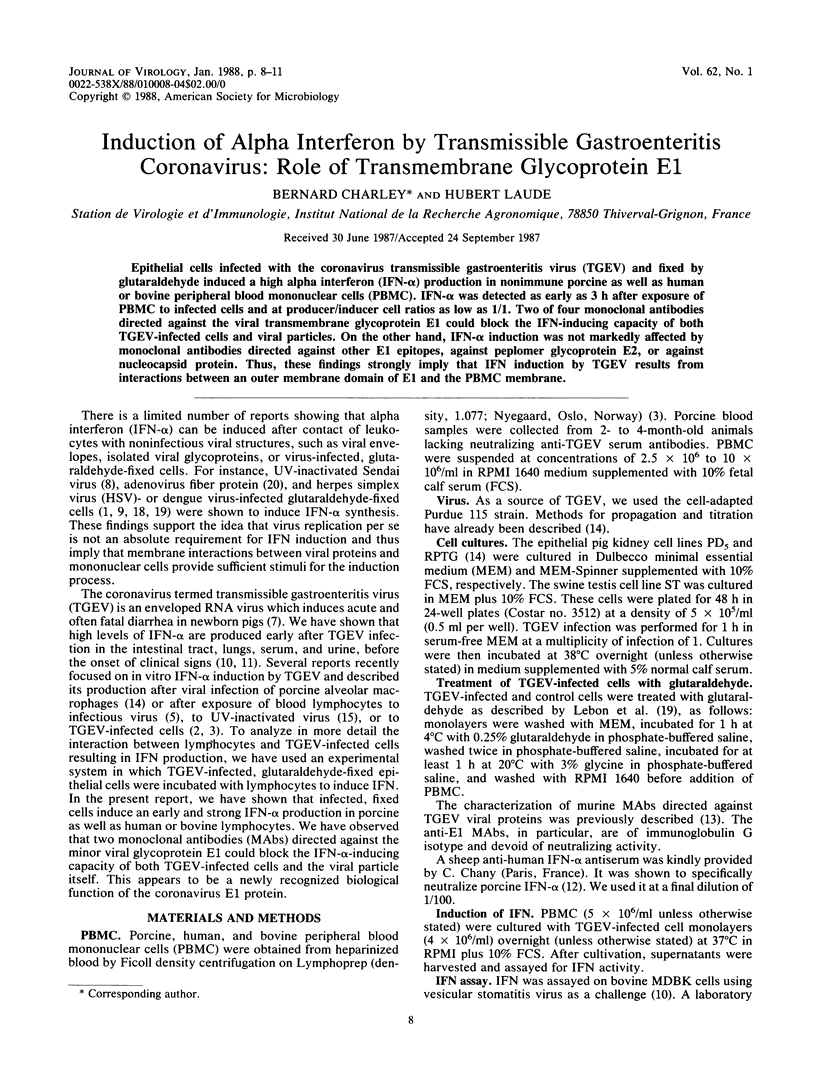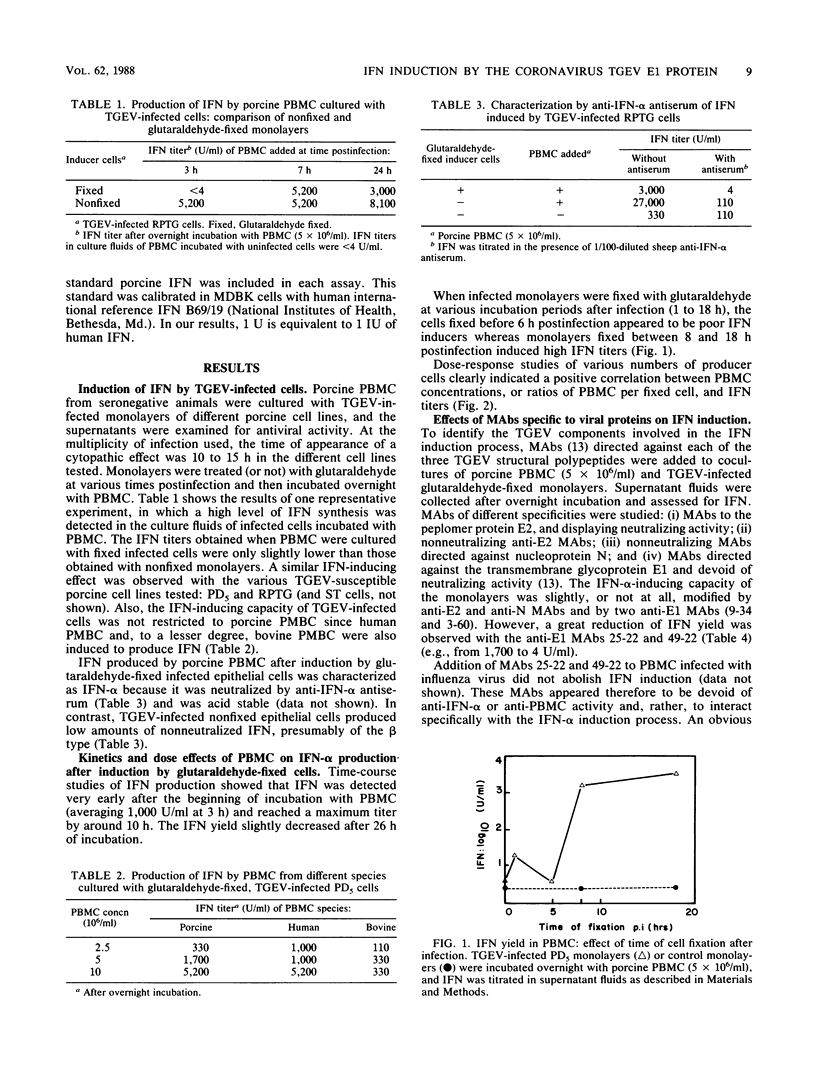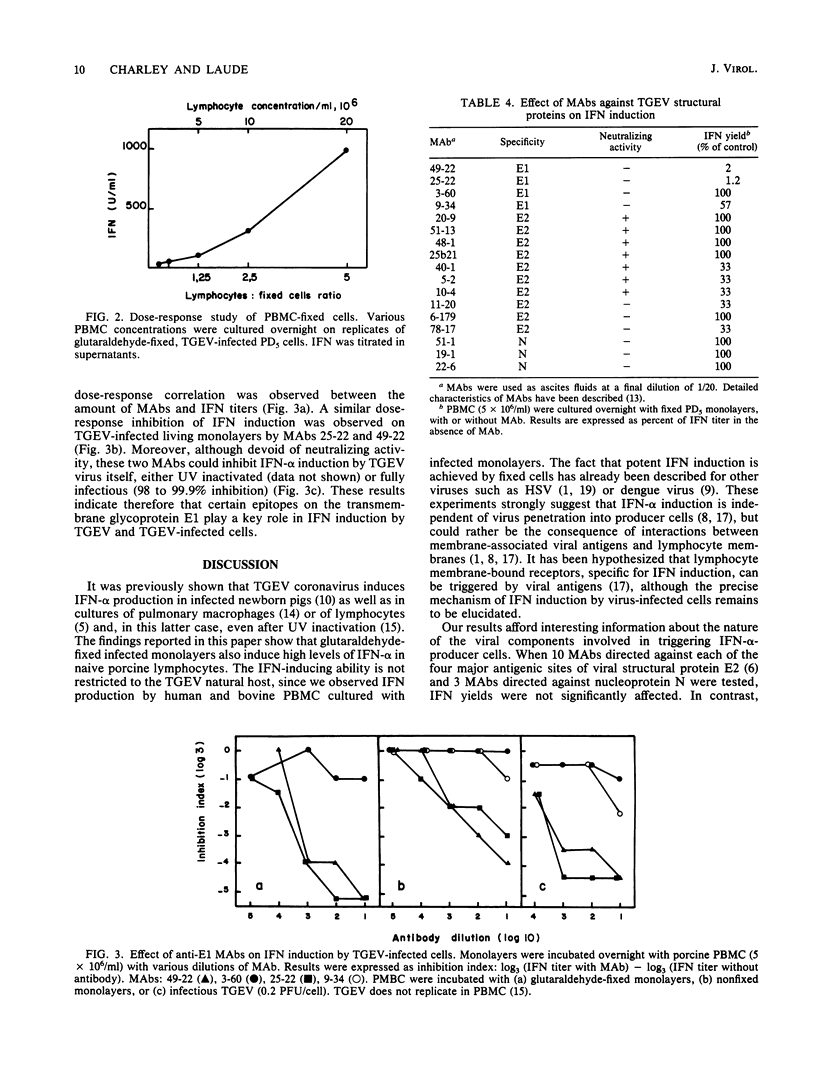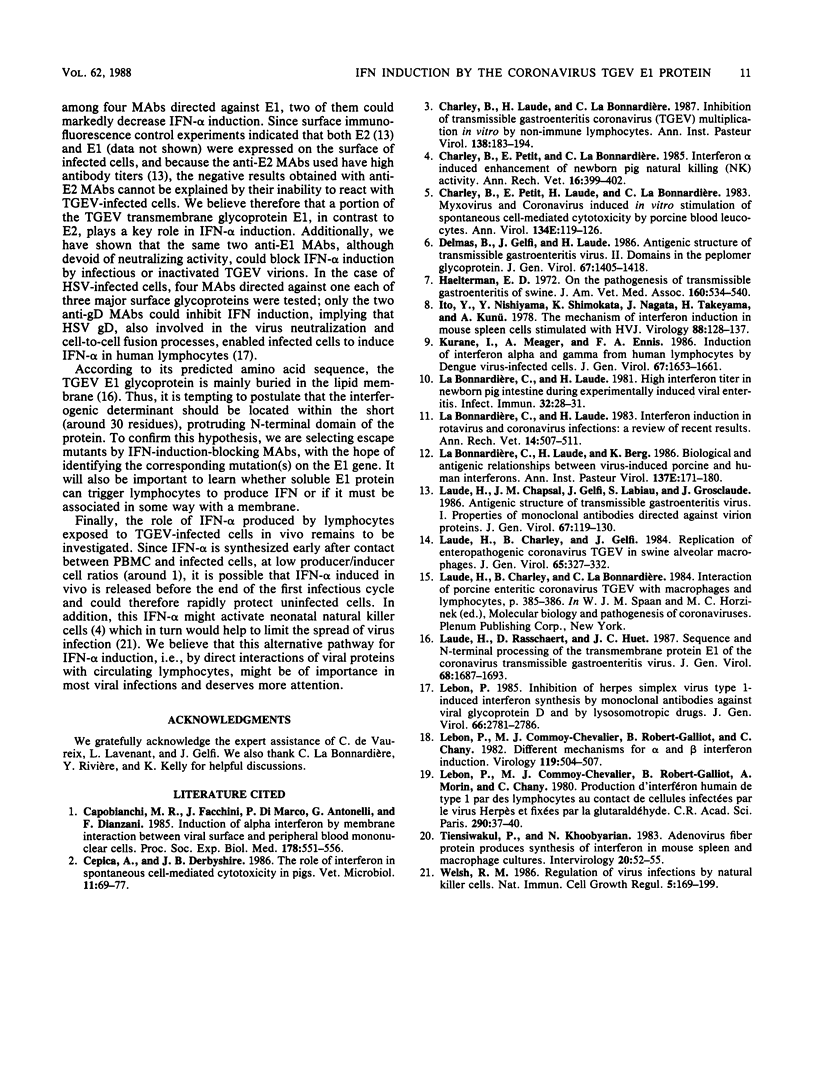Abstract
Epithelial cells infected with the coronavirus transmissible gastroenteritis virus (TGEV) and fixed by glutaraldehyde induced a high alpha interferon (IFN-alpha) production in nonimmune porcine as well as human or bovine peripheral blood mononuclear cells (PBMC). IFN-alpha was detected as early as 3 h after exposure of PBMC to infected cells and at producer/inducer cell ratios as low as 1/1. Two of four monoclonal antibodies directed against the viral transmembrane glycoprotein E1 could block the IFN-inducing capacity of both TGEV-infected cells and viral particles. On the other hand, IFN-alpha induction was not markedly affected by monoclonal antibodies directed against other E1 epitopes, against peplomer glycoprotein E2, or against nucleocapsid protein. Thus, these findings strongly imply that IFN induction by TGEV results from interactions between an outer membrane domain of E1 and the PBMC membrane.
Full text
PDF



Selected References
These references are in PubMed. This may not be the complete list of references from this article.
- Capobianchi M. R., Facchini J., Di Marco P., Antonelli G., Dianzani F. Induction of alpha interferon by membrane interaction between viral surface and peripheral blood mononuclear cells. Proc Soc Exp Biol Med. 1985 Apr;178(4):551–556. doi: 10.3181/00379727-178-42041. [DOI] [PubMed] [Google Scholar]
- Cepica A., Derbyshire J. B. The role of interferon in spontaneous cell-mediated cytotoxicity in pigs. Vet Microbiol. 1986 Feb;11(1-2):69–77. doi: 10.1016/0378-1135(86)90008-8. [DOI] [PMC free article] [PubMed] [Google Scholar]
- Charley B., Petit E., La Bonnardière C. Interferon-induced enhancement of newborn pig natural killing (NK) activity. Ann Rech Vet. 1985;16(4):399–402. [PubMed] [Google Scholar]
- Delmas B., Gelfi J., Laude H. Antigenic structure of transmissible gastroenteritis virus. II. Domains in the peplomer glycoprotein. J Gen Virol. 1986 Jul;67(Pt 7):1405–1418. doi: 10.1099/0022-1317-67-7-1405. [DOI] [PubMed] [Google Scholar]
- Ito Y., Nishiyama Y., Shimokata K., Nagata I., Takeyama H., Kunii A. The mechanism of interferon induction in mouse spleen cells stimulated with HVJ. Virology. 1978 Jul 1;88(1):128–137. doi: 10.1016/0042-6822(78)90116-2. [DOI] [PubMed] [Google Scholar]
- Kurane I., Meager A., Ennis F. A. Induction of interferon alpha and gamma from human lymphocytes by dengue virus-infected cells. J Gen Virol. 1986 Aug;67(Pt 8):1653–1661. doi: 10.1099/0022-1317-67-8-1653. [DOI] [PubMed] [Google Scholar]
- La Bonnardiere C., Laude H. High interferon titer in newborn pig intestine during experimentally induced viral enteritis. Infect Immun. 1981 Apr;32(1):28–31. doi: 10.1128/iai.32.1.28-31.1981. [DOI] [PMC free article] [PubMed] [Google Scholar]
- La Bonnardière C., Laude H. Interferon induction in rotavirus and coronavirus infections: a review of recent results. Ann Rech Vet. 1983;14(4):507–511. [PubMed] [Google Scholar]
- Laude H., Chapsal J. M., Gelfi J., Labiau S., Grosclaude J. Antigenic structure of transmissible gastroenteritis virus. I. Properties of monoclonal antibodies directed against virion proteins. J Gen Virol. 1986 Jan;67(Pt 1):119–130. doi: 10.1099/0022-1317-67-1-119. [DOI] [PubMed] [Google Scholar]
- Laude H., Charley B., Gelfi J. Replication of transmissible gastroenteritis coronavirus (TGEV) in swine alveolar macrophages. J Gen Virol. 1984 Feb;65(Pt 2):327–332. doi: 10.1099/0022-1317-65-2-327. [DOI] [PubMed] [Google Scholar]
- Laude H., Rasschaert D., Huet J. C. Sequence and N-terminal processing of the transmembrane protein E1 of the coronavirus transmissible gastroenteritis virus. J Gen Virol. 1987 Jun;68(Pt 6):1687–1693. doi: 10.1099/0022-1317-68-6-1687. [DOI] [PubMed] [Google Scholar]
- Lebon P., Commoy-Chevalier M. J., Robert-Galliot B., Chany C. Different mechanisms for alpha and beta interferon induction. Virology. 1982 Jun;119(2):504–507. doi: 10.1016/0042-6822(82)90109-x. [DOI] [PubMed] [Google Scholar]
- Lebon P., Commoy-Chevalier M. J., Robert-Galliot B., Morin A., Chany C. Production d'interféron humain de type I par des lymphocytes au contact de cellules infectées par le virus herpès et fixées par le glutaraldéhyde. C R Seances Acad Sci D. 1980 Jan 7;290(1):37–40. [PubMed] [Google Scholar]
- Lebon P. Inhibition of herpes simplex virus type 1-induced interferon synthesis by monoclonal antibodies against viral glycoprotein D and by lysosomotropic drugs. J Gen Virol. 1985 Dec;66(Pt 12):2781–2786. doi: 10.1099/0022-1317-66-12-2781. [DOI] [PubMed] [Google Scholar]
- Tiensiwakul P., Khoobyarian N. Adenovirus fiber protein produces synthesis of interferon in mouse spleen and macrophage cultures. Intervirology. 1983;20(1):52–55. doi: 10.1159/000149374. [DOI] [PubMed] [Google Scholar]
- Welsh R. M. Regulation of virus infections by natural killer cells. A review. Nat Immun Cell Growth Regul. 1986;5(4):169–199. [PubMed] [Google Scholar]


